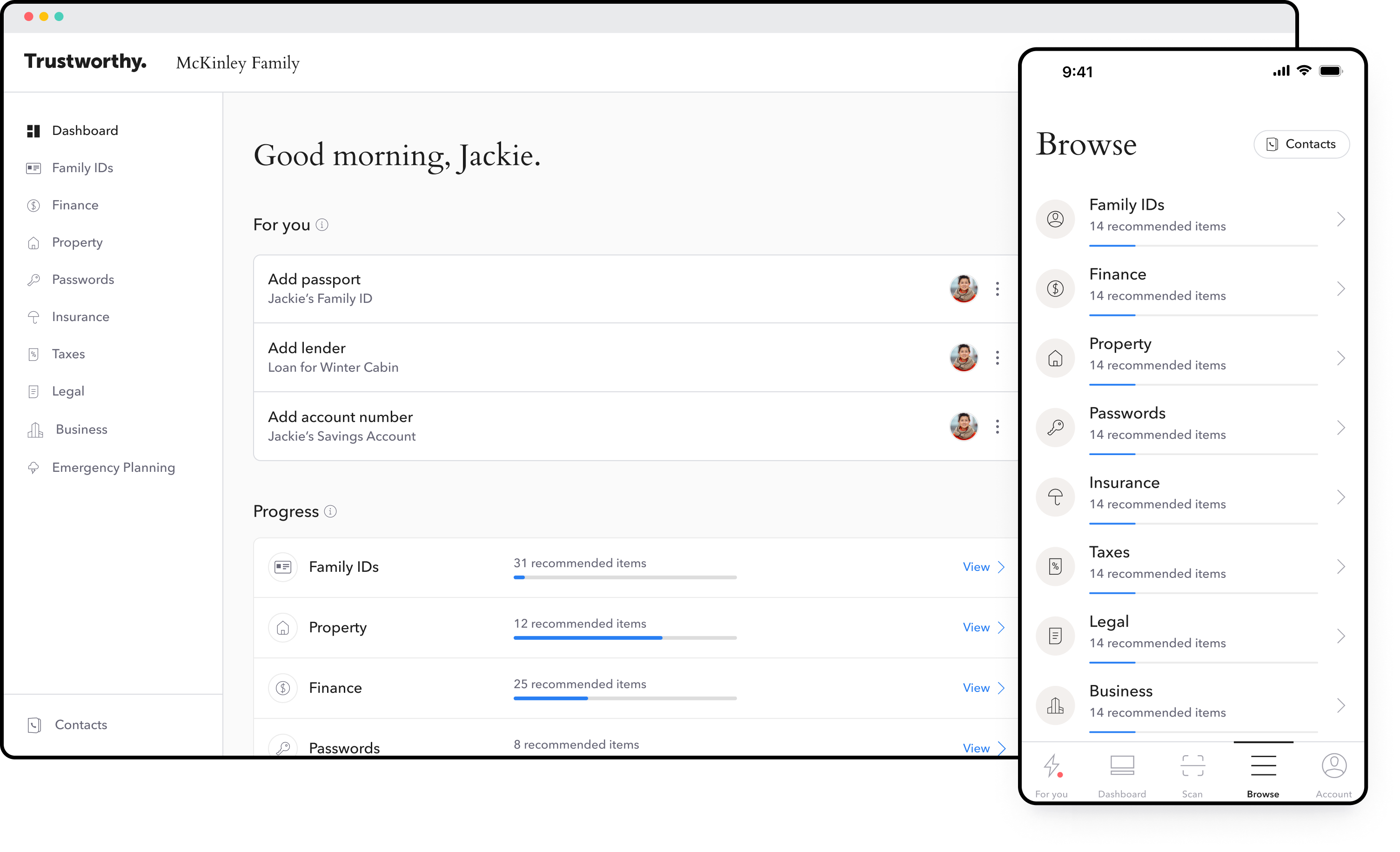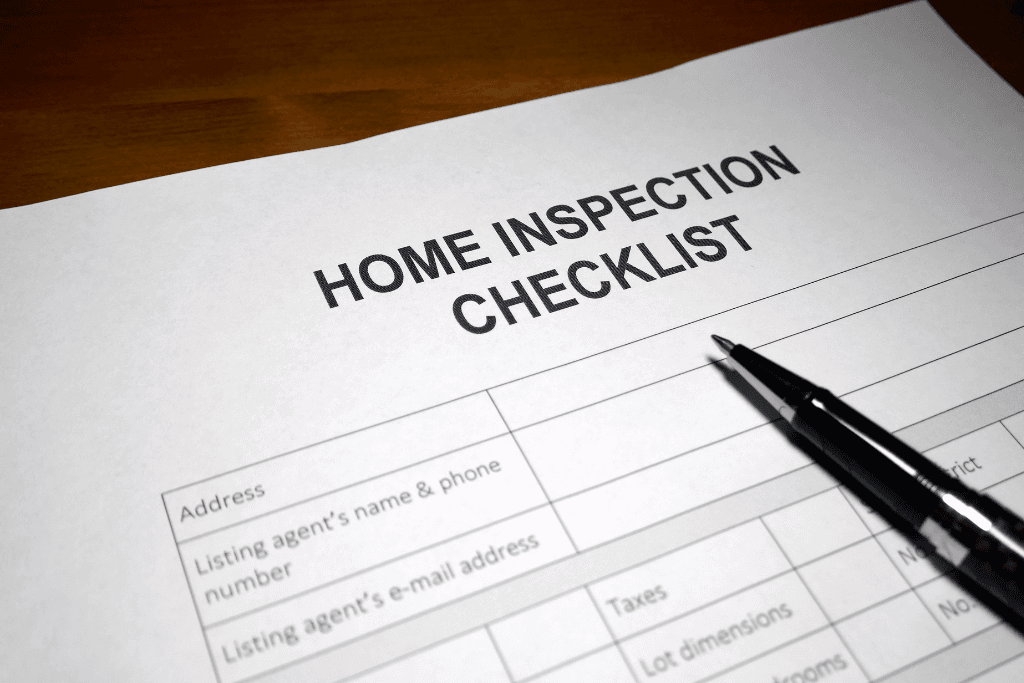
Key Takeaways
After tornadoes, first assess damage by surveying building exteriors before entering, taking stock of documents (present and undamaged, missing, or damaged), and cross-referencing against digital backups or inventories.
Gather essential restoration tools including gloves, plastic containers, paper towels, drying racks, document repair tape, ruler, and fan, plus investing in dehumidifiers to remove excess moisture and prevent mold.
Wet documents can be air-dried by gently separating pages and laying flat in well-ventilated areas with fans, or freeze-dried by placing in freezer within 48 hours to prevent mold and preserve better until professional restoration.
Professional document restoration services can recover severely damaged documents through specialized techniques, with decisions based on document value, sentimental importance, and damage extent.
Trustworthy's Family Operating System® allows creating digital copies of essential family documents (IDs, insurance, birth certificates) before disasters, providing readily accessible references during restoration and safeguarding against future damage.
Property damage is often the number one concern after a tornado unleashes its fury. But you must also consider the safety of your critical family documents. It can often be incredibly difficult to recover and repair storm-damaged documents.
Read on to find out how to assess storm damage, how to repair wet or torn documents, and why you should ensure all your family documents are digitized.
Assess the Damage and Safety First
After the storm has finished and the dust has settled, your first step is to assess the damage caused.
Just remember to prioritize your family’s safety above all else. Survey the exterior of the building or room where your documents have been stored before entering. If there are signs of structural damage, stay out. Wait for a structural engineer to inspect the building before entering.
Next, take stock of the documents at the property. Identify which documents are:
Present and undamaged
Missing
Damaged
The best way to do this is to cross-reference what you can find on-site against any digital backups, document inventory, or photos you have of your document storage system before the storm.
By categorizing each document, you can gauge the scope of your restoration job and prepare to get to work.
Gather Essential Tools for Document Restoration
After assessing the damage, it’s time to gather the tools you’ll need to try and restore your documents.
These may vary depending on whether your documents have incurred water damage or have been torn and need mending. But generally speaking, you can tackle any restoration job with:
Gloves
Plastic containers
Paper towels
Drying racks
Document repair tape
A ruler
A fan
It’s also worth investing in a dehumidifier.
This will remove any excess moisture in your home or business, so you don’t have to worry about recurring damage, mold, or mildew as you work to recover documents.

If you back up your documents using a digital vault like Trustworthy, you’ll also want to have digital versions of your documents accessible as a point of reference.
Trustworthy's dynamic and intuitive Family Operating System® enables you to quickly create digital copies of essential family documents, so they’re always available and accessible. This is a great way to safeguard against damage because you can back up your family IDs, insurance documents, birth certificates, and everything in between.
By having these digital documents on hand, you can better understand what each document should look like in its entirety and undamaged state.

How to Dry Wet Documents: Air-Drying vs. Freeze-Drying
Once you identify damaged documents and gather the tools required for repairs, it’s time to consider which repair method you should go for.
The two most popular ways to repair wet documents damaged by a storm are air-drying or freeze-drying, although many people use both methods simultaneously. We’ll explain why in just a minute.
Air-drying is recommended for a small number of documents. It’s a cheap and effective method of document restoration, but it can be very time-consuming.

Simply follow these steps:
Find a clean, dry, and temperature-controlled place with low humidity where you can dry your documents.
Cover your tables or drying racks with clean paper towels.
Turn on a fan to circulate air in the room, but do not point the fan directly at your documents.
Carefully peel documents apart and place them on a drying rack.
From there, repeat until all of your water-damaged documents are separated. The amount of time it takes them to air-dry will depend on what type of paper the documents are made of and the moisture levels in the space where you dry them.
Because the process of air-drying is time-consuming, it’s often used alongside the freeze-drying method.

If you have a large number of water-logged documents, experts recommend freezing them immediately. This gives you more time to set up a suitable space to air-dry. It also prevents the spread of mold.
There are two types of freeze-drying you can pursue. You can either place documents in an ordinary domestic freezer and separate items yourself, or you can use a vacuum freezer.
When you vacuum freeze documents, the items are placed in a vacuum chamber, and the air is sucked out of the chamber as the temperature remains below freezing. This removes the moisture from damaged documents without having to air-dry them.
Vacuum freezing is considered one of the most effective methods, but you’ll need to contact a specialist recovery company to support you with this. If you’re working with a small number of documents, it may end up being pretty expensive, but the process can be cost-effective if you need to recover a higher volume of items.
How to Handle Torn or Fragile Documents
If your documents are or start to crumble after air-drying, you must consider whether repair is possible.
Assuming you decide it’s possible (or necessary) to repair a torn document, here are the steps you should follow:
Place your document on a flat surface or cutting mat.
Align the edges of the tear on your document.
Cut a piece of document repair tape and apply it to the document’s rear.
Gently press down the tape to remove air bubbles.
Flatten the document and press it between heavy objects.
Leave the repaired document for a few hours to ensure the adhesion works. After that, remove your document and repeat until all of your damaged documents are restored.

Using Professional Document Restoration Services
It’s one thing to separate water-logged invoices or insurance policies in your home office after a tornado. But if you’re dealing with high-value documents or irreplaceable items like 120-year-old family photos that haven’t been digitized, you might want to hire professional restoration experts.
There is a wide range of local, regional, and national companies operating across the U.S. that specialize in document recovery. It’s worth shopping around to make sure you’re able to get a responsive and affordable service near your home.
Many document restoration services operate 24/7 and can be on-site quickly to help you assess damage and take away documents in need of separating.
When contacting providers, be sure to ask about the methods used, the possibility of vacuum freezing documents, and how services are priced. Using a professional service definitely isn’t the most cost-effective way to recover storm-damaged documents, but it will remove the stress of trying to dry documents yourself (and save you a lot of time).
Move Recovered Documents to Digital Storage

After you recover your documents, consider digitizing them.
Andrew Pickett, a trial attorney at Andrew Pickett Law PLLC in Florida, says: “In my years of practice, I've seen firsthand how safeguarding documents can prevent future headaches. Imagine the inconvenience of trying to reconstruct a legal history or financial records — it's often an overwhelming task. …
“Digitally backing up documents isn't just a neat addition; it’s an essential step. The ease with which one can retrieve data from cloud storage, compared to the painstaking process of document restoration, speaks volumes.”
That’s where Trustworthy can make life a whole lot simpler, both after the storm you’ve just faced and going into any future tornado events.
Trustworthy is an intuitive digital vault that makes digitizing your family documents fast and easy. You can drag and drop documents onto your Trustworthy dashboard, scan documents using your mobile phone, or upload items directly and securely from your email inbox.
This streamlines the process, so you don’t have to waste days scanning documents. Meanwhile, your uploaded documents are all kept under lock and key using bank-level 256-bit AES encryption, multi-factor authentication, and tokenization.
With Trustworthy, you can grant one-off, remote access to documents to whoever needs them, whether it’s family members, your attorney, accountant, medical provider, or others.
Want to learn more? Check out Trustworthy’s range of features to discover how it can save you time, money, and a huge headache should a tornado strike.
Preventing Future Damage to Important Documents
“Disasters can strike at any time, and if it happens, you’ll have a lot on your mind,” says Andy Phillips, vice president of The Tax Institute at H&R Block.
“If you’re able to find time to prepare your records and safeguard them as well as implement processes for your family, it will save a lot of time down the road.”
In practice, that prevention starts with creating digital backups of all your important documents.
As we’ve already pointed out, it’s worth partnering with a platform like Trustworthy to ensure you can back up your documents quickly and efficiently. Trustworthy even offers templates and prompts to remind you of various items you may want to consider uploading or updating.
After backing up items, store the original copies somewhere that will minimize damage. For example, it’s worth investing in a water-proof safe or document bag so they’ll be safe from water damage (even if your property is damaged in a storm).
However, according to H&R Block’s Phillips, it’s also important to create an inventory of valuable items in your home before a storm takes place, even if it’s a matter of taking photos of what’s in your property.
“Photograph or videotape the contents of your home, especially to document valuable possessions," he says. "A photographic record can help you prove the market value of items for insurance and casualty-loss claims. Store the photos or video with a friend or family living outside the area.”
Insurance and Legal Assistance for Lost Documents

In terms of property damage, it’s essential to take stock of the damage as quickly as possible.
Make sure you take photos of damage, because this will be helpful in terms of calculating the financial loss you’ll need to report to your insurance provider. Your insurance company will probably ask for this sort of documentation later on in the claims process.
“Keep your receipts. Certain expenses might be deductible, and they could be helpful in determining your loss. Receipts for contracting work can show how much you lost and confirm the use of insurance reimbursements,” says Andy Phillips of The Tax Institute at H&R Block.
“Food, medical supplies, and other forms of assistance aren’t taxable. These items also don’t reduce the amount you can claim as a loss unless they replace lost or destroyed items.”
If you’ve lost documents or they’re too damaged to salvage, you’ll need to try to replace them where possible. This will involve getting in touch with the relevant government body and following replacement procedures.
For example, let’s say you lose your Social Security card in a tornado. You’ll need to complete Form SS-5 and bring it to your local Social Security office alongside an up-to-date ID in order to acquire a replacement card.
There will be different replacement processes for each document type, whether it’s a passport, birth certificate, or marriage license.
When in doubt, get in touch with the organization that issued the original document. They should be able to guide you through the process of getting a replacement.
Frequently Asked Questions
What should I do if my documents are moldy or stuck together?
If documents are moldy or stuck together, freeze them. This will minimize damage and prevent the spread of mold while you prepare to separate and air-dry the documents.
What types of documents can be restored?
Most paper documents can be restored under the right conditions. However, you must act quickly and follow the correct processes to recover them. When in doubt, speak with a document recovery specialist.
We’d love to hear from you! Feel free to email us with any questions, comments, or suggestions for future article topics.















